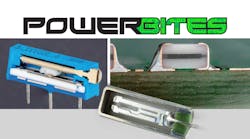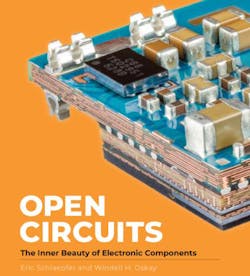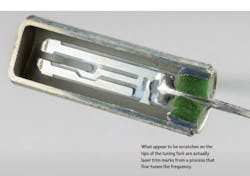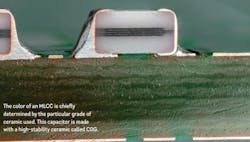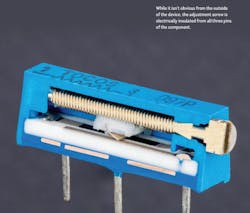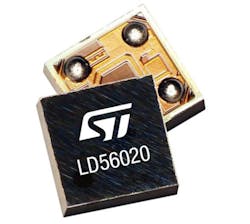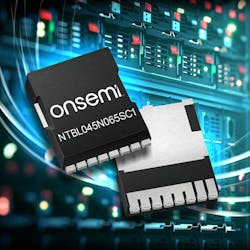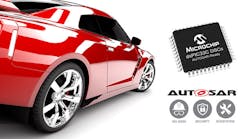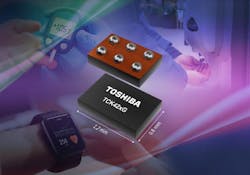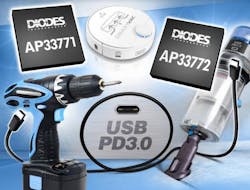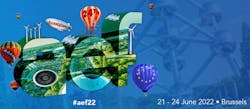This Week in PowerBites: The Hidden Beauty of Electronics
This article is part of the This Week in PowerBites Library Series.
Two Renegade EEs Explore the Beauty Hidden Inside Everyday Electronics
Open Circuits is a photographic exploration of the beautiful designs lurking inside the electronic products and components many of us have worked with during our careers. Its stunning cross-section photography unlocks a hidden world full of elegance, subtle complexity, and wonder.
The book's authors, Eric Schlaepfer and Windell H. Oskay, provide fascinating examples of how our phones, computers, and appliances are made of hundreds of internal components, each precisely engineered to perform a certain function, but none intended to actually be seen. Through painstakingly executed, vividly detailed cross-section photography, Open Circuits reveals the surprising—and often accidental—beauty hiding inside the electronic components that drive our everyday devices.
From resistors to LEDs, USB cables to headphone jacks, stepper motors to nixie tubes, the book’s arresting imagery transforms more than 130 components into delightful works of art. As you visually dissect the components’ insides, you’ll learn about how they work and how they were made. Open Circuits has something for everyone to appreciate, whether you’re a seasoned electrical engineer, an amateur tinkerer, or simply a lover of art and photography.
You owe it to yourself to take a few minutes to enjoy the first chapter (Passive Components) for free by clicking https://nostarch.com/download/OpenCircuits_Chapter1.pdf. Once you do, you many never look at a resistor the same way again.
Open Circuits is available as a print or eBook at $39.99 and $31.99, respectively. There’s a 25% pre-order discount going on for the next month or so. You can learn more about the book and how to order it here: https://nostarch.com/open-circuits.
Low-Noise, Low-Voltage Regulator Targets Energy-Conscious Applications
STMicroelectronics’ LD56020, a 200-mA low-dropout voltage regulator that operates with a supply from 1.1 to 5.5 V, has low output noise for applications that demand excellent stability and long battery runtime.
Well-suited for mobiles, vision sensors, and wireless modules, the competitively priced LD56020 has extremely low dropout voltage of just 190 mV (max. at full load) and maximum quiescent current of 25 µA at light load. An external enable pin permits control logic to put the regulator into standby mode, reducing current below 0.1 µA.
With a supply-voltage rejection (SVRIN) value of 90 dB (1 kHz, 20 mA) and output noise of just 8.8 µVRMS (10 Hz to 100 kHz), the LD56020 provides a clean power rail for low-voltage digital circuitry. The circuit is stabilized with only one small ceramic capacitor at each of the input and output terminals. In addition to minimizing the bill of materials, the low overall component count combines with the regulator’s tiny chip-scale package (CSP) outline of 0.65 × 0.65 mm to ensure a compact circuit footprint with low impact on PCB size.
The regulator integrates protection features including short-circuit current foldback and undervoltage lockout to prevent excessive dissipation in the event of a system fault. There’s also overtemperature protection and an internal discharge path.
The LD56020 is in production now in the CSP-4 chip-scale package, priced from $0.14 for orders of 1,000 pieces. For further information, visit www.st.com/ldo.
Highly Integrated PoE and KNX Solutions Accelerate Building-Automation Apps
Two complete system solutions introduced by onsemi support the most widely used building-automation network protocols: Power over Ethernet (PoE) and KNX. By providing end-to-end support for both protocols, these fully integrated devices shorten development of smart-building control panels and connected lighting.
The NCL31010 is a complete solution for Ethernet-powered connected lighting that integrates an intelligent LED driver and PoE interface into a single package. This provides support for both the lighting and power-delivery requirements of fully connected and managed lighting systems.
The IEEE 802.3bt-compliant NCL31010 can deliver over 90 W via PoE. An innovative application for this device, made possible by the highly efficient buck LED driver, is called Visible Light Communication (VLC).This involves modulating data directly onto the LED light, which remains imperceptible to the human eye, allowing it to broadcast data and function as a location beacon for use in indoor positioning systems.
Easing the development of access and control panels, the NCN5140S is the first system-in-package (SiP) certified with the KNX Association. The NCN5140S integrates all critical and certifiable elements of a KNX device, including a digital KNX transceiver, a 32-bit Arm Cortex-M0+ microcontroller with a pre-certified software stack, and system power dc-dc converters, into a single package. With its high degree of integration, the NCN5140S considerably reduces material costs and allows manufacturers to develop very slim and modern designs (<5 mm total depth).
Pre-Certified Products Shorten Time to Market
Because the NCN5140S platform is pre-certified, products based on the device inherit this compliance. Thus, they don't have to undergo the rigorous KNX certification process normally required for new products. All that’s needed is a KNX declaration of product modification, eliminating the time and engineering efforts of a complete certification process. The NCL31010 and the NCN5140S* are available now through onsemi sales support and authorized distributors.
ISO 26262-Compliant, AUTOSAR-Ready Devices Simplify Automotive Designs
As the market for electric and autonomous vehicles grows, so does the need for AUTOSAR, ISO 26262 functional-safety-compliant and secure solutions. To meet these needs, Microchip Technology announced a rich ecosystem of devices, development tools, and support resources for its AUTOSAR-ready dsPIC33C Digital Signal Controllers (DSCs).
Created for applications that require large memories, the new ISO 26262-compliant dsPIC33CK1024MP7xx, equipped with 1 MB of flash, can easily run automotive software like AUTOSAR, OS, MCAL drivers, ISO 26262 functional-safety diagnostics, and security libraries. The family of dsPIC33 DSCs also includes a high-performance CPU with deterministic response and specialized peripherals for general automotive, advanced sensing and control, digital-power, and motor-control applications.
With the extensive set of development resources and automotive-grade reference designs, customers can improve their project's risk and complexity management while decreasing development time through reusability. The AUTOSAR ecosystem for the dsPIC33C DSCs includes MICROSAR Classic from Vector, KSAR OS from KPIT Technologies Ltd., and ASPICE- and ASIL B-compliant MCAL drivers from Microchip.
The company expanded its functional-safety packages to include FMEDA reports, safety manuals, and diagnostic libraries to cover the ISO 26262-compliant dsPIC33CK1024MP7xx DSCs. These AUTOSAR-ready dsPIC33C DSCs, used together with Microchip’s TA100 CryptoAutomotive security ICs, enable the implementation of robust security in automotive designs.
Development Tools
Software and tools from Microchip Technology include certified MPLAB XC16 compiler functional-safety licenses, MPLAB X Integrated Development Environment (IDE), MPLAB Code Configurator (MCC), programming and debugging tools for dsPIC33C DSCs, ISO 26262- and ASPICE-compliant MCAL drivers for dsPIC33C DSCs, ISO 26262 functional-safety packages for dsPIC33C DSCs, and software libraries and reference code for security use cases.
Availability
For information about the dsPIC33CK1024MP708 DSCs, which offer up to 100-MHz real-time performance, 1-MB flash, dual CAN FD interfaces and dedicated peripherals for advanced sensing and control, digital power, motor control, and high-performance general automotive applications, visit www.microchip.com/dsPIC33CK1024MP708. For more about the ISO 26262 functional-safety packages, secure solutions, and tools ecosystem for the AUTOSAR-ready dsPIC33C DSCs, visit www.microchip.com/dsPIC33-Automotive or contact a Microchip sales representative.
Miniature MOSFET Gate-Driver Family Targets Portable Applications
Toshiba Electronics added five new MOSFET gate-driver ICs to its TCK42xG series that will find homes primarily in battery-powered consumer and industrial equipment. The devices in this series support back-to-back connection of external N-channel MOSFETs. In addition, they control the applied gate voltage independent of the input voltage and feature an overvoltage lockout function to protect the circuit.
Like Toshiba's TCK421G, announced earlier this year, the gate drivers in the series can be selected for a gate-source voltage of 10 or 5.6 V, allowing them to be used with most low- and medium-power MOSFETs. A choice of detection voltages for the input overvoltage lockout allows them to operate from power lines from 5 to 24 V. The drivers include the TCK420G for 24-V power lines, TCK422G and TCK423G for 12 V, TCK424G for 9 V, and TCK425G for 5 V.
Each new driver in the series features a built-in charge pump that ensures a stable gate-source voltage at the external MOSFET, while the input can vary from 2.7 to 28 V. This allows large currents to be switched. In addition, when used to control two N-channel MOSFETs connected back-to-back, they’re suitable for configuring load-switch or power-multiplexer circuits with reverse-current blocking.
Housed in a 1.2- × 0.8-mm WCSP6G package, one of the smallest in the industry, Toshiba’s TCK42xG gate drivers have a tiny footprint that allows for high-density mounting in space-constrained portable products. They also have a low input OFF current (IQ(OFF)) of 0.5 μA (maximum, at VIN = 5 V) that helps to prolong battery runtime.
To further assist customers’ projects, Toshiba has developed the Power Multiplexer Circuit Reference Design, which provides a design example for power multiplexers that utilize the functions of TCK42xG. The reference design is available here. More information about Toshiba's TCK42xG MOSFET gate driver ICs can be found here.
USB PD 3.0 Sink Controllers Enable Streamlined and Cost-Effective Charging Solutions
Diodes Incorporated expanded its portfolio of USB power-delivery (PD) solutions with two new high-performance USB PD 3.0 sink controller ICs, the AP33771 and AP33772. Targeted at home appliances and cordless power tools, both devices can negotiate the voltage to be delivered to their host's power system (between 3.3 and 24 V) via the USB-C protocol.
The AP33771’s required voltages and power are set externally by tying several control pins to the appropriate voltage level. In contrast, the AP33772 provides greater flexibility for more sophisticated designs that use a microcontroller (with an I²C interface included).
Both devices have built-in application firmware, which can automatically negotiate the desired power and voltage levels with an attached USB PD 3.0 charger. The controllers include a GPIO port to drive a series of LEDs that indicate charging status and any fault states.
The AP33771 has a preloaded power menu consisting of eight different output voltages and 10 different power levels. The power requirements of the end equipment can be met via alteration of simple resistor settings. It also provides 5-V charging when connected to a classic USB Type-A charger, as well as supports USB Type-C cable voltage-drop compensation.
The I²C interface on the AP33772 makes it possible to address more sophisticated system designs. Through it, particular power profiles can be specified, as well as enabling access to various protection features.
The AP33771 and AP33772, supplied in 24-pin W-QFN4040 packages, are priced at $0.5201 in 1,000-piece quantities. Evaluation boards are available through Diodes’ sales channel upon request.
African Energy Summit Welcomes Young Entrepreneurs and Innovators
The Youth Energy Summit (YES!) shows why not all of the innovations needed to enable the world's transition to sustainable energy will be coming from large corporations or developed nations. The event, held in Brussels from June 21-24 as part of the Africa Energy Forum, will enable the next generation of energy leaders to develop the network, connections, and knowledge needed to take on the task of electrifying Africa.
Technologists and entrepreneurs alike will find new ideas and opportunities at both YES! and its parent event, the AEF. The video below shows highlights from last year’s AEF:
YES! was conceived as a large-scale youth and early-career focused initiative, intended to serve as a next step toward building human capital within Africa’s energy sector and making energy projects more likely to fully succeed. The Summit's program will cover a broad range of topics related to the development of a robust, sustainable energy infrastructure throughout Africa, including:
- How technology is breaking down barriers to international development, personal growth, and crucial grass-roots opportunities.
- Preparing the next generation of African energy professionals: Bridging the gap between educators and companies within the African energy sector.
- How new technologies, innovation, and change are leveling the playing field for students, entrepreneurs and early career professionals: How do we prepare 100,000 new entrepreneurs and business developers for the jobs that don’t currently exist?
- With 50% of the world’s population under 30 living on the continent by 2050, what could the future look like if money, technology, and electricity access were unlimited?
Additional information on YES! can be found at https://bit.ly/3N83GMz.
Read more articles in the This Week in PowerBites Library Series.
